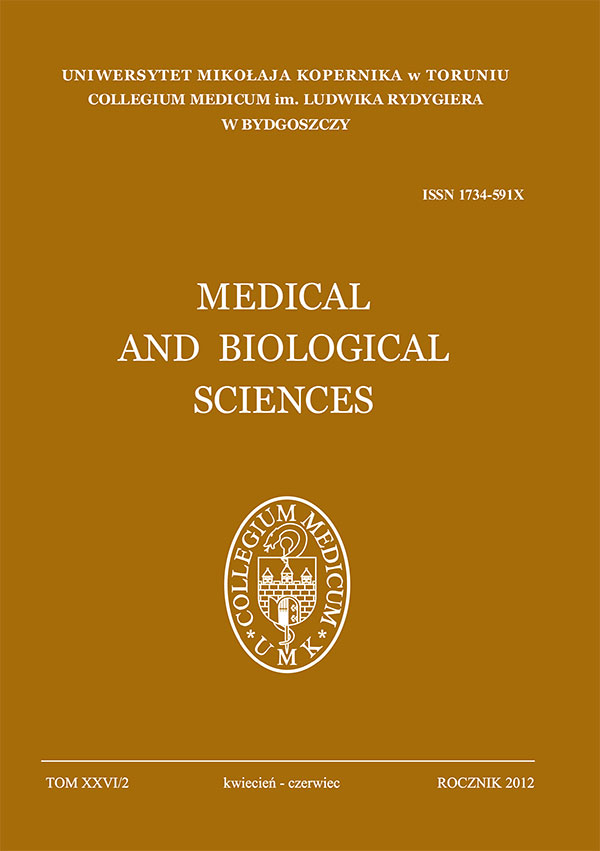Intrarater repeatability of manual testing of first muscle movement resistance
DOI:
https://doi.org/10.12775/4052Keywords
muscle movement resistanceAbstract
First resistance in passive muscle lengthening is very important in both diagnosis and treatment in many muscle disorders. Many therapeutic methods use this muscle length as a point of reference. All of them assume that a therapist is able to feel this moment during manual muscle testing in precise and repeatable way. In this paper assumption regarding repeatability of such test is verified.
The study included 34 tests conducted on 17 participants, both men and women, aged 35.6 (±8.5). Every test consisted of three trials on passive ankle dorsiflexion, performed by a single, skilled therapist. Joint angle and estimated length of triceps surae muscle was recorded in realtime measurement using ZEBRIS system and set of four active ultrasound markers. Results of that test shows that standard deviation and range of results between minimal and maximal in each trial for both ankle joint and muscle length were below 1 degree and millimeter respectively. Standard error of this measurement for joint and muscle length were below 0.5 degree and millimeter, respectively. This lead to conclusion that manual testing of first resistance in manual muscle lengthening performed by skilled therapist has a very good repeatability.
References
Kaltenborn FM „Kręgosłup. Badanie manualne i mobilizacja.“ Wydawnictwo Rolewski, Toruń, 1998.
Lewit K „Terapia manualna w rehabilitacji chorób narządu ruchu” III wyd. ZL Natura, 2001.
Maitland G.D “Vertebral Manipulation” 6th Edition, Butterworths, London 2001.
Lisowski J, Hagner W “Terapeutyczna moc rozciągania mięśni. Ćwiczenia w procesie autoterapii I profilaktyki najczęstszych dolegliwości I dysfunkcji narządu ruchu” Remedium, Włocławek 2005.
Cyriax JH., Cyriax PJ “Cyriax’s Illustrated Manual of Orthopaedic Medicine” Butterworth-Heinemann Ltd, Oxford 1993.
Magee DJ .Orthopedic Physical Assessment. Wyd IV. Pennsylvania, Philadelphia: Elsevier Sciences; 2002.
Kaltenborn FM „Manualne mobilizacje stawów kończyn.“ Wydawnictwo Rolewski, Toruń, 1996.
Myers WT "Anatomy Trains" I ed. Churchill Livingstone, 2001.
Kase K, Wallis J, Kase T "Clinical therapeutic applications of the Kinesiotaping Method", KinesioTaping Association, 2003.
Rakowski A “Kręgosłup w stresie. Jak pokonać ból i jego przyczyny” III wyd, Gdańskie Wydawnictwo Psychologiczne, Gdańsk 2001.
Kaltenborn FM, Kaltenborn TB, Vollowitz E “Manual Mobilization of the Joints, Vol.III. Traction- Manipulation of the Extremities and Spine: Basic Thrust Techniques” Norli, 2008.
Triano JJ (2001) Biomechanics of spinal manipulative therapy, The Spinal Journal vol. 1, Pp.121-130.
Błaszczyk JW „Biomechanika Kliniczna” Wydawnictwo Lekarskie PZWL; Warszawa 2004.
Bober T, Zawadzki J „Biomechanika układu ruchu człowieka” Wyd. 2. Wydawnictwo BK, Wrocław 2003.
Dylewski M, Rzepka R (2009) “Możliwości obiektywnej oceny postawy ciała z wykorzystaniem czynnych i biernych markerów.” W: Nowotny J. (red.): Wady postawy ciała u dzieci i młodzieży. Wydawnictwo Wyższej Szkoły Administracji w Bielsku-Białej, Bielsko- Biała, 75-84.
Chateau H, Girard D, Degueurce C, Denoix J-M (2003) „Methodological considerations for using a kinematic analysis system based on ultrasonic triangulation” ITBMRBM Volume 24, Issue 2, Pages 69-78.
“WinData 2x for Windows. Operating instructions” ZEBRIS MEDICAL Gmbh Isny im Allgau, 2006.
Będziński R „Biomechanika Inżynierska. Zagadnienia wybrane” Oficyna Wydawnicza Politechniki Wrocławskiej, Wrocław 1997.
Brumagne S, Cordo P, Lysens S, Verschueren S, Swinnen S. (2000) The role of paraspinal muscle spindles in lumbosacral position sense in individuals with and without low back pain. Spine;25(8):989-94. DOI: http://dx.doi.org/10.1097/00007632-200004150-00015
Cholewicki J, van Diee¨n JH, Arsenault AB (2003) Muscle function and dysfunction in the spine. J Electromyogr Kinesiol 13:303-304.
Published
How to Cite
Issue
Section
Stats
Number of views and downloads: 0
Number of citations: 0



